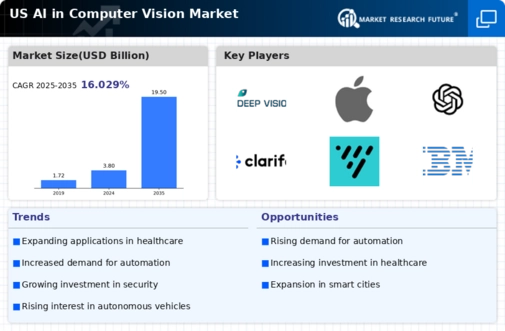Growing Interest in Smart City Initiatives
The AI in Computer Vision market is benefiting from the growing interest in smart city initiatives across the United States. Cities are increasingly leveraging AI technologies to improve urban infrastructure, enhance public safety, and optimize traffic management. For instance, AI-powered cameras and sensors are being deployed to monitor traffic patterns, reduce congestion, and improve emergency response times. This trend is expected to drive significant investments in AI-driven technologies, with estimates suggesting that smart city projects could reach a market value of over $1 trillion by 2025. As municipalities seek to create more efficient and livable urban environments, the ai in-computer-vision market is likely to play a crucial role in these developments.
Advancements in Machine Learning Algorithms
The AI in Computer Vision market is significantly influenced by advancements in machine learning algorithms. These innovations enable more accurate image recognition and processing capabilities, which are essential for various applications, including facial recognition, object detection, and scene understanding. As machine learning techniques evolve, they allow for the development of more sophisticated models that can learn from vast datasets, improving their performance over time. This is particularly relevant in sectors such as retail and healthcare, where precise image analysis can lead to better customer insights and improved patient outcomes. The increasing availability of high-quality training data is also contributing to this trend, suggesting that the ai in-computer-vision market will continue to benefit from these technological advancements in the foreseeable future.
Increased Focus on Data Privacy Regulations
The AI in Computer Vision market is increasingly influenced by the heightened focus on data privacy regulations. As concerns about data security and privacy grow, companies are compelled to adopt AI solutions that comply with stringent regulations. This shift is particularly relevant in sectors such as finance and healthcare, where sensitive data is frequently processed. Organizations are investing in AI technologies that not only enhance operational efficiency but also prioritize data protection. The implementation of privacy-centric AI solutions is expected to drive market growth, as businesses seek to balance innovation with compliance. This trend indicates that the ai in-computer-vision market will continue to evolve in response to regulatory pressures, shaping the development of future technologies.
Integration of AI in Manufacturing Processes
The AI in Computer Vision market is witnessing a transformative shift as manufacturers increasingly integrate AI technologies into their production processes. This integration facilitates real-time quality control, predictive maintenance, and enhanced operational efficiency. By employing AI-driven visual inspection systems, manufacturers can detect defects and anomalies in products at an unprecedented rate, reducing waste and improving overall product quality. Recent statistics indicate that the adoption of AI in manufacturing could lead to a reduction in operational costs by up to 30%. As industries strive for greater efficiency and competitiveness, the ai in-computer-vision market is poised for substantial growth, driven by the need for smarter manufacturing solutions.
Rising Demand for Enhanced Security Solutions
The AI in Computer Vision market is experiencing a notable surge in demand for advanced security solutions. Organizations across various sectors are increasingly adopting AI-driven surveillance systems to enhance security measures. This trend is particularly evident in urban areas, where crime rates have prompted the need for more sophisticated monitoring technologies. According to recent data, the market for AI-based security systems is projected to grow at a CAGR of approximately 20% over the next five years. This growth is driven by the need for real-time threat detection and response capabilities, which traditional systems often lack. As businesses and governments invest in these technologies, the ai in-computer-vision market is likely to expand significantly, providing innovative solutions that address security challenges effectively.

















Leave a Comment